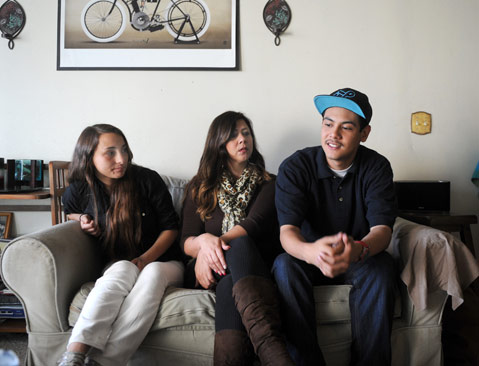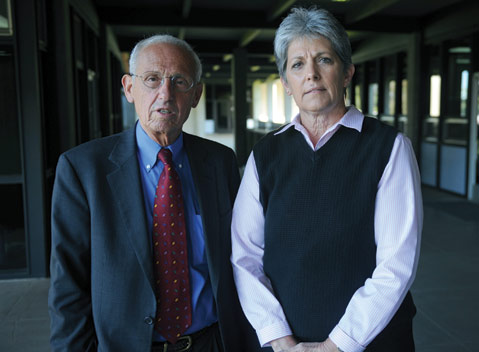Busted Structure
The Fault Lines and Fallout of El Puente's Collapse

Its death turned out to be as controversial as its life. El Puente Community School, which will close for good in June along with satellite campuses at the Police Activities League and Community Action Commission, will leave behind a number of vulnerable students who have had trouble succeeding in a traditional high school setting. In the past two weeks, they showed up to both Santa Barbara County Education Office (SBCEO) and Santa Barbara Unified School District board meetings pleading with administrators to keep their school open and groping for answers about why the school is shutting down.
Their confusion may have something to do with the odd way in which the news was announced. To this date, a press release has never been issued. A letter that went out to parents announcing the decision was written only in English before a translation was eventually sent. One mother approximated that about 65 percent of El Puente parents primarily speak Spanish. And the SBCEO — which runs the school for kids who are chronic truants, on probation, or simply desire a more structured setting where they can catch up on credits — must pay rent on El Puente’s 430 East Gutierrez Street location until June 2014, that is, unless they can find a sublessee, which they have not yet done.

When confronted with the suggestion that SBCEO could have reached out to the community before deciding to close El Puente, Jan Clevenger, an assistant superintendent, said, “It’s something to be resolved and worked out between the district and the county office instead of putting it out in the community and letting everybody with an opinion tell us what we need to do.”
In this climate, rumors have festered. And in the offices of the Santa Barbara district, staff have sneered at the fact that on March 28, two weeks after deciding to close El Puente, County Superintendent Bill Cirone sent a letter to all SBCEO staff announcing a 1.08 percent raise retroactive to July 1. “Our current negotiated contracts with the certificated and classified bargaining units call for passing along funded state [Cost of Living Adjustments],” reads the letter. Of the SBCEO’s 716 employees, 483 are union members. The cost of the office-wide raise is $440,000. Cirone said he would have been glad to give his staff a raise for the first time in three years, even if it wasn’t obligated. Criticism about him putting money toward salaries that could have otherwise been spent on El Puente, he said, could be leveled about “any program, any year, any deficit.”
It was on March 13 when he met with David Cash, superintendent of S.B.’s Unified School District (SBUSD), and told him that if the district could not pay for El Puente’s deficit, about $330,000, he would have to close the school. Cash said he was surprised, but school site administrators were not.
Assistant principals at Dos Pueblos and Santa Barbara high schools said in separate conversations that, although they were surprised by the timing of El Puente’s closing, they “could see the writing on the wall.” Attendance had been plummeting the last couple of years, and two years ago, some staffing changes were made. SBCEO officials maintain that SBUSD, by keeping more kids in the district, signaled that El Puente was no longer necessary. Cash, however, said he did not want El Puente to close, and he had not issued an explicit policy to avoid sending kids to the alternative school. Dos Pueblos Assistant Principal Jorge Fulco surmised that successful community intervention programs may have played a role. Since 2009, the annual count of expulsions was 37, 31, 37, and 18, with six so far this year.
Some believe that the drop in enrollment coincided with the institution of an Alternative Education Committee (AEC) in 2009. This committee consisted of both district and county employees who review referrals to county-run schools as well as decisions to bring kids back to district schools. One explicit purpose of the committee is to decide whether the needs of special-education students can be met at El Puente. For years, the school has been excoriated by activists for warehousing special-education students who don’t receive proper accommodations at their regular schools, and furthermore criminalizing them.
Bill Cirone said it’s “categorically not true” that SBCEO was screening out special-education students to avoid lawsuits or public scrutiny. Referral numbers made available by SBCEO only go back two years. Last year, 11 special-education students were referred from SBUSD, and six were enrolled. This year, out of five special-education referrals, three were enrolled.
El Puente has also been viewed as a concrete example of inequitable treatment of Latinos in Santa Barbara’s public schools since severity of discipline tends to escalate more quickly for them. Currently, 91 percent of El Puente’s students are Hispanic or nonwhite “other.”
“They’re going to be bored; they’re going to get arrested; they’ll be in the juvenile system.”
While such criticisms may have merit, they are certainly not universally felt. Many of El Puente’s students felt as if the school provided an environment where they were cared about for the first time in their lives. According to Keith Terry, executive director of the at-risk youth intervention nonprofit yStrive, “A lot of these young kids grow up with no structure. They don’t know that they are getting three meals a day. Their homes are chaotic. When they go into [El Puente], it has structure. It has boundaries.” He believes the real-world consequences of the school closing will be more kids on the street. “They’re going to be bored; they’re going to get arrested; they’ll be in the juvenile system.”
Martin Leyva, a facilitator for the Academy of Healing Arts, begs to differ. He said that he feels bad for the staff at El Puente who may lose their jobs and who genuinely care for the kids, but “the first thing that went through my mind was, ‘Good, let’s let these kids reintegrate [into district schools] and be proactive in their learning.’” While he understands that some students need more structure, Leyva, a former prison inmate, said, “When I’ve walked into El Puente and I notice that the teachers have radios and the kids have to walk in single file with hands behind their back and there are no windows … I get triggered. They’re training the kids’ brains to memorize this controlled way of being.”
Moreover, Leyva believes that reintegration will offer a true test of Santa Barbara Unified’s shift toward restorative justice —
a process whereby reconciliation must be integrated into discipline. While the district is only in its first year of piloting a Restorative Approaches framework at Santa Barbara Junior High School, Fulco at Dos Pueblos believes the restorative ethos has already taken hold across the district and may also explain a dip in expulsions the past couple of years.
Meanwhile, said Marlin Sumpter, a district assistant superintendent, staff is in the process of “meeting with each student and parent at El Puente, looking at transcripts, anticipating where they will be on credit recovery, and looking at the best way to bring them back.” The district may open its own miniature version of El Puente and has considered joining forces with other county districts to form an alternative school, but no decisions have been made. Cirone said that he is still willing to offer support but maintains SBUSD must share the burden of the cost.



